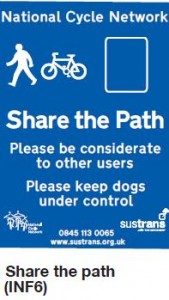 Jon is Sustrans Regional Manager and has kindly responded to the post on cycle lane paint and to a comment about signage on the National Cycle Routes.
Jon is Sustrans Regional Manager and has kindly responded to the post on cycle lane paint and to a comment about signage on the National Cycle Routes.
Below Jon clarifies a number of issues about responsibility for signage. There is no DfT guidance for local authorities on cycle signage. That may be a good thing given some of their “maddening regulation” on road signs and infrastructure, but I think it also shows that they don’t take cycling seriously as a mode of transport. Jon’s comments:
Signing is a bit of a black art – it’s quite tricky to get right, and there’s a huge amount of detail to collect in preparation for signing. In most circumstances, Local Authorities simply won’t take responsibility for signing the National Cycle Network and the route ends up being signed with the temporary volunteer signs, which become permanent features on routes up and down the country. In the case of the Two Tunnels, and as prescribed by our standard MoU, it is the responsibility of the delivery agent (in this case Sustrans) to sign the route. However, we don’t have the authority to place signs on the highway without the Highway Authority’s permission. This gets even more complicated when new posts are needed at junctions.
In the case of the two projects currently at the design stage in Bath this year, Bellotts Road Bridge and the crossing of the Lower Bristol Road, the Local Authority is the delivery agent and therefore has the responsibility to sign the route.
Just a quick note about the coloured surfacing discussed in the post. There are essentially three types: coloured tarmac; coloured high friction surfacing and coloured slurry seal.
Coloured tarmac provides the most durable, smooth surface. However, it needs special stone (red or green – and the green doesn’t come in a type suitable for use on the highway as far as I know), and a colourless binder. This means specially cleaned machinery needs to be brought in for the job to stop the job being spoiled with the tar normally used to bind the stone together.
Coloured high friction surfacing is currently the most popular solution in our area, its applied with a resin, then the coloured surface spread across the top. It costs about £13-15/m2, so it’s not cheap, and it tends to wear out, and then there’s never any money to replace it. Someone once told me that there’s approx £2million worth of coloured high friction surfacing on bus and cycle lanes across Bristol, and no strategy as to how to deal with its replacement.
Slurry seal is simply a coloured resin (with some grit to provide skid resistance). This is the type used for the Cycle Super Highways in London and it can be more slippery than the other two above, but gives a more vibrant colour. I’ve never used it, so don’t know how long it lasts compared to the other two.
Interestingly, there’s no regulation on colours used on the public highway despite our maddening regulatory framework for lines and signs. So Bath could go pink if it wanted!

 Hello, I'm Roger Symonds and I have created this blog to highlight local and wider cycling issues. Given the incredible interest and increase in cycling we must not miss this opportunity to provide the the infrastructure that gets even more people out on bikes in a safer environment.
Hello, I'm Roger Symonds and I have created this blog to highlight local and wider cycling issues. Given the incredible interest and increase in cycling we must not miss this opportunity to provide the the infrastructure that gets even more people out on bikes in a safer environment.